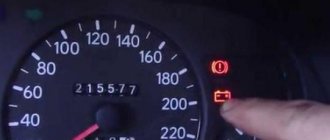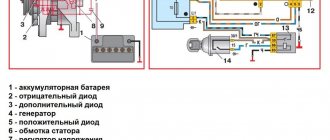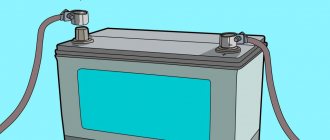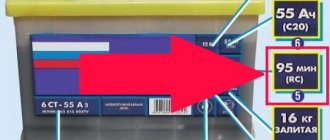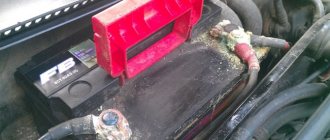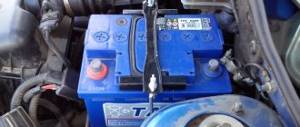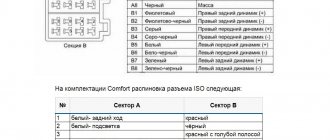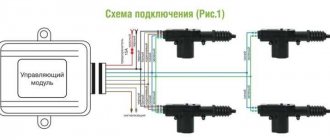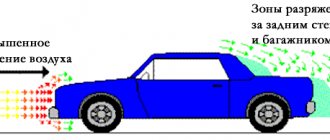The vehicle battery serves as its most important component and, despite the simple design of the device, contains a number of important characteristics: polarity, capacity, starting current.
Not all motorists understand what starting current is. Often, when buying a new battery, they immediately make a serious miscalculation, leading to rapid breakdown of the generator or the inability to start the vehicle in frosty weather.
What does inrush current mean?
This is the maximum current strength that will be needed to start the engine, and specifically to energize the starter in order to turn the crankshaft flywheel along with the pistons. This procedure is quite complicated, because the pistons press on the fuel (9 - 13 At) entering the chambers. In winter, starting the device is more complicated, because the lubricant becomes thicker and the starter needs to overcome both compression and insufficient lubrication of the cylinders.
The main function of the battery is to accumulate energy and then start the engine, and although the structure of most models is largely similar, their characteristics are different. The usual voltage is about 12.7 Volts, but the current and battery capacity are different. If the battery capacity is about 60 Ah, then this will exceed its standard value by about 4-5 times. However, this voltage should only be supplied for approximately 30 seconds.
Important! If 200 - 220 A is enough to start a car engine at +1-5°C, then to start it already at -10-15° it is necessary to consume 30% more electrical energy, i.e. 260 - 270 Amperes.
The lower the temperature in winter, the higher the starting current.
What starting current should be
The optimal starting current is determined by the manufacturer. Batteries with the same capacity, but produced in different countries, have different capacities. For companies in China and Europe, the difference reaches 30–40% and depends on the type of products, which, according to the method of service, are:
- serviced;
- unattended;
- flooded;
- dry charged.
Maintained batteries are characterized by monitoring the electrolyte level and its density. The optimal level is achieved by adding distilled water.
Currently, most vehicle owners are inclined to use maintenance-free batteries. Service life reaches 5 years. There is no need to monitor the electrolyte level, just monitor the voltage at the terminals. The optimal charge provides the magnitude of the starting force. Filled batteries are immediately suitable for use.
Dry-charged ones have the advantage of long-term storage without operation, the period lasts from 3 to 5 years. Dry-charged power supplies are ready for use. Electrolyte is poured in, the plates are soaked for an hour, followed by charging. All actions are performed according to the operating instructions.
What the starting current should be is decided by the owner of the car. The size and power of the engine and the climatic conditions in which the vehicle is operated should be taken into account. Please refer to the owner's manual for your specific vehicle.
The starting current value is indicated on the battery case.
Below is an approximate table of battery capacity corresponding to engine volumes.
Table 1.
| Capacity, Ah | 55 | 60 | 66 | 77 | 90 | 140 | 190 | 200 |
| Volume engine, l | 1 – 1,6 | 1,3 –1,9 | 1,4 – 2,3 | 1,6 – 3,2 | 1,9 – 4,5 | 3,8 – 10,9 | 7,2 – 12 | 7,5 – 17 |
There are differences between batteries in the composition of the electrolyte, as well as manufacturing technology. Batteries can be acidic or alkaline, and each of them has its own starting current parameters.
Classic technology involves the production of electrodes and mastic from alloys of lead with antimony and calcium. Calcium alloy power supplies last up to 7 years and take longer to discharge, so they cost more. Inrush currents in classic batteries are 4-5 times greater than the rated capacity.
In contrast to the classics, AGM technologies are developing rapidly. In such sources of electric current, the liquid acid electrolyte is bound by synthetic mats. Lead with a high degree of purity is used for electrodes.
Pros of AGM battery:
- unattended;
- are not afraid of deep discharge;
- service life 5 – 12 years.
Batteries manufactured using AGM technology are operated with increased starting currents. If we take batteries of the same capacity, then the starting force is 40% greater than that of conventional acid batteries. The disadvantage is the high cost (6,000-10,000 rubles), and charging requires a special charger.
Another promising direction of GEL is developing – technology. The electrodes are no different (positive and negative). The internal cavities are filled with a special gel, which hardens after hardening. The pores are filled with electrolyte, the plates are wrapped in gel, which prevents shedding. Short circuit is excluded.
The minimum operating time is 7 years. The starting current is almost 1.5 times higher than in batteries manufactured using AGM technology. Among the disadvantages are the high cost (today 15,000-27,000 rubles) and increased charging requirements.
Let's consider the values of starting currents from Russian and foreign manufacturers and their ratio. Manufacturers from different countries have adopted their own standards:
The approximate value of the starting current can be calculated using instruments.
Manufacturers from different countries and unions have adopted their own standards:
- Russian Federation – GOST 599 – 91, 599 – 2002.
- The German standard is DIN.
- European Union - EN 60095 - 1.
- US standard – SAE J.
We bring to your attention a table that shows the correspondence of cold start currents according to the standards given above.
Table 2.
| DIN 43559, GOST 599 – 91 | EN 60095 – 1, GOST 599 – 2002 | SAE J537 |
| 170 | 280 | 300 |
| 220 | 330 | 350 |
| 255 | 360 | 400 |
| 255 | 420 | 450 |
| 280 | 480 | 500 |
| 310 | 520 | 550 |
| 335 | 540 | 600 |
| 365 | 600 | 650 |
| 395 | 640 | 700 |
| 420 | 680 | 750 |
From what is presented it is clear that the standard in Russia is close to German and European.
What factors influence
The value of the indicator is influenced by several factors:
- Type of motor. To start a petrol 1.5 liter. this figure will be approximately 180 A, for a 1.5 liter diesel engine. - 300 A.
- Engine size (the larger the size, the more difficult it is to start it).
- Temperatures of the external atmosphere and lubricant.
- The degree of compression of the fuel in the cylinder.
It should be noted that the engine does not start instantly, and usually the starter will take from 0.3 to 1.5 seconds. to achieve starting cranks.
Engine starting speed is the number of crankshaft revolutions per minute at which the engine is able to continue functioning on its own. Now gasoline engines can start at 40-70 rpm, diesel engines - at 100-200 rpm.
If you look at different manufacturers, for example, European countries, the Russian Federation, China or the USA, then this indicator is different for all their generators. If we compare 55 A in Europe and China, the difference sometimes reaches 30-40%. What happens due to the difference in the technological processes used:
- the use of pure lead even in the simplest batteries will lead to a high rate of charging and further discharging, and, consequently, the starting performance will increase;
- increased volume of electrolyte;
- more records in an equal-sized case;
- the plus plates are more porous, which allows for higher charge accumulation;
- the tightness of the structure prevents the evaporation of the electrolyte, which allows the battery to constantly maintain the required level;
- manufacturing material.
It is also important to consider the quality of the build.
You can also notice that when the motor starts, the voltage drops to about 9 V, but the current increases many times - this is the norm. After the start, it will again reach the normal level of 12.7 V, and the expended charge will restore the vehicle’s battery. If the indicators drop to 6 V at start (with a long recovery), then this is a bad sign, because the starter mechanism will simply not have enough energy to start the car. The generator's life is probably running low.
The approximate ratio of the starting current of the car battery and the battery capacity is 10 to 1.
Advice! A very discharged generator has a cold cranking current and capacity that is significantly less than the factory values. And this interferes with normal starting.
Another factor that causes starting difficulties is severe wear of the motor and its malfunctions.
How to properly charge the battery?
The charger must be able to output up to 17 volts if the battery operating voltage is 12 volts. Otherwise, you will not be able to charge the battery 100%.
In addition, you need to take into account the battery capacity when choosing the level of the supplied starting current to the car battery, the table of which is presented below. For example, if the battery has a capacity of 70 Ah, then to charge for 10 hours it is necessary to set the current to 7 A. Gradually, the current should be reduced with a parallel increase in voltage. This method will make it possible to fill the battery life more efficiently: as the charge level increases, the resistance also increases, but the battery’s operation is still aimed at voltage, which is why it should be increased.
What happens when the engine starts
For a more visual representation of what is happening with the battery, let’s study the oscillogram taken from the starter contacts.
The diagram shows the start of a 1.5 liter engine. on gasoline when using a battery with a capacity of 60 Ah with a starting current of 500 A. The starting time is 1.2 seconds, which is indicated by the scale at the bottom of the graph, during this period the crankshaft speed increased to 200 rpm.
Red in the figure shows the change in current strength (left scale). Blue indicates the voltage graph (right scale).
You can easily see that after just a few fractions of a second of starting the car, the consumption instantly increased to 350 A, at the same time the voltage dropped to 8.5 V. But after just 0.1 seconds, the volume decreased more than twice and became equal to 125 A, and the voltage began to exceed 10 Volts.
The rest of the time (a little more than 1 second), the car’s starter used about 75 A, with jumps during ignition in each of the cylinders. The voltage gradually increased to 12 V towards the end of the start-up, and then increased to 14 Volt - the process of charging the generator began.
Now it is clear that any start of the engine will be some kind of strength test for the battery.
Important! If the generator does not have a reserve (cold start current + required energy to start), then when the engine starts, the voltage will drop to 7-8 V. And the spark formation process may be disrupted or the ECU will reboot, which is why the start will not take place.
Due to the fact that the time required to start the engine is quite short (about 30 seconds), the average battery indicators are enough to start the car right away.
Verification methods
The test procedure is designed to reproduce the conditions during winter starting of the car. This is not the easiest way to estimate inrush current. But it is considered the most reliable.
The standards are defined as follows:
- The battery is placed in a refrigerator and the temperature is reduced to -18°C.
- After this, a discharge current is sent to the device, which is equal to the rated starting current. Let's say the device has a starting current of 300A, which means the discharge current should also be 300A.
- For a device to pass the test, its voltage must not drop below the specified standard.
But first, we need to say a few words about world standards, which directly affect the final result. But the thing is that in different countries the starting current has its own standards.
- European Union (Europa Norm) - after discharge current for 10 seconds. the charge should not fall below 7.5A.
- Germany (DIN) – battery after 50 sec. should not discharge below 9V.
- USA (SAE) - after the discharge current was sent to the device, after 50 seconds. the voltage should not fall below 7.2V.
Important! Russian GOST has exactly the same standards as in Germany.
There are also so-called launch testers. They induce a powerful pulse that corresponds to the rated inrush current. Using Ohm's law, the device calculates the battery resistance, and then reads the starting current data. This way you can check your data much faster. But the result may not be entirely accurate.
How to find out the required indicator for a specific car
A diesel engine will require a higher starting current than a gasoline engine, since the compression level is significantly exceeded, up to 20 At.
Average parameters:
- diesel engine - 300 Ampere;
- on gasoline - 255 Amperes.
These values were measured at a temperature of -18°, and this most likely will not allow the car to start in colder conditions.
True, with the improvement of technology, indicators of 400-600 A are often observed in expensive car models.
Undoubtedly, it is necessary to find out the parameters of the car, but a value of 450-500 A is enough for any region of the Russian Federation.
The check is also carried out by special testers. The most famous:
- Midtronics;
- Bosch BAT-131;
- DHC.
The price of the measuring apparatus is 50-70 thousand rubles. An analogue from China can be bought for 10-15 thousand rubles. There are estimated deviations between cheap and expensive devices, but all measuring instruments can detect an “empty” battery. After all, such a generator has an indicator that is significantly less than the average error of the device, i.e. a small value of the indicator will immediately indicate a dummy. They have this value with a capacity of 60 Ah 300-400 A, and the lowest starting current of the starter for such a battery should be 470-480 A.
What is it measured in? Methods
There are classifications of indicator values that have their own methods for calculating the starting current of the starter, and abbreviations. Let's find out how this is indicated on the battery:
- in Germany, manufacturers make DIN markings;
- in the USA - SAE;
- in EU countries (except Germany) – EN;
- in the Russian Federation they often indicate “starter”.
If you are unsuccessful in finding the characteristics on the cover or sides of the battery, you need to find out the information from the seller. Indicators may also be in the descriptions supplied with the battery.
The newest batteries have excellent indicators in different measurement modes. Sometimes motorists are not able to see their difference according to DIN, TU (Russian Federation) from SAE or EN.
The choice of battery will be made correctly if we apply the ratio of the starter discharge current according to SAE and EN to this indicator according to DIN and Specifications, which is equal to 1.7:
IEN = 1.7 IDIN.
If a value according to a specific standard is indicated on a certain battery, then through this relationship it is not difficult to calculate the discharge current indicator set using a different method.
Cold cranking current ratio:
| DIN 43559, GOST 959-91 | SAE J537 | EN 60095-1, GOST 959-2002 |
| 170 | 300 | 280 |
| 220 | 350 | 330 |
| 280 | 500 | 480 |
| 365 | 650 | 600 |
| 420 | 750 | 680 |
Remember, with a higher cold start current, it is easier to start a car engine in winter, but due to the increased load on the engine, its operating reserve is sometimes reduced.
What is the correspondence of cold cranking currents according to different standards?
Battery starting power is the maximum output power that the battery can produce for 30 seconds at a temperature of minus 18°C . This indicator characterizes the battery's ability to start a cold engine .
As is known from electrical engineering, power is characterized by the product of the discharge current and the average voltage in the circuit. P = I · U
I – starter discharge current at a temperature of -18°C ( cold cranking current ); U is the arithmetic mean value of the discharge voltage measured at regular intervals.
For lead-acid batteries , with an increase in the discharge current during the starter discharge mode (discharge mode of the battery when the engine is started by the starter ), the average voltage decreases noticeably. Therefore, taking into account the constancy of the starting current, the more power expended by the battery when starting the engine, the lower the voltage at its terminals will be, that is, the slower the engine will rotate with the starter. It turns out that the higher the power of the battery, the faster the starter will “turn” the engine , the easier it is to start it.
More cold cranking current means more battery power!
To compare the power of rechargeable batteries, it is enough to compare their starting current ( cold cranking current ), reduced to a unified test method ( EN, SAE, DIN, IEC, GOST , etc.).
The starter discharge of the battery (abroad - short discharge by the manufacturer is carried out with a certain duration (continuously or intermittently) up to a voltage of 6 V. At the same time, the regulatory documents indicate intermediate intervals from the beginning of the discharge ( 5 seconds, 10 seconds or 30 seconds), during which the voltage of the battery is monitored during the discharge process. The battery's energy reserve , characterized by the starter discharge time, shows how long it can support attempts to start the engine . Simply put, the larger the battery capacity , the more attempts the car owner has to start the engine .
Initially, the choice of batteries is made by the developers of the car engine starting system. In this case, the discharge characteristics of the battery are used in the calculation at a state of charge of 75% on the 3rd attempt at the starter discharge. The temperature conditions for starting the engine are set by the car designer. As a rule, the starting temperature of a carburetor engine using commercial oils is assumed to be ?20°C , and for diesel engines up to?15°C...?17°C . For the latter, at lower temperatures, starting aids will be used (aerosol, heating of fuel, oil, air, etc.). Similar means of relief in winter conditions can be used to start carburetor engines (passenger cars, trucks). The starter battery selected by the developers based on its discharge characteristics in the vehicle’s technical passport after laboratory and operational tests . According to this document, car owners, as a rule, replace a failed old battery with a new one.
Modern starter batteries indicate several indicators in different modes of their determination. Not every car enthusiast can understand the difference between the cold cranking current according to DIN (Germany) or TU ( GOST 959-91 , Russia) and the cold cranking current according to SAE (USA) or EN (European Union Standard). Outwardly it is obvious that the current value according to SAE or EN is significantly greater than according to TU (GOST 959-91) or DIN . When discharging with these currents, voltages of different magnitudes are assumed at the battery pole terminals. At an electrolyte temperature of ≤18°C, discharge with currents according to SAE and EN assumes a voltage at the pole terminals of the battery of 7.2 V at the 30th second and 7.5 V at the 10th second, respectively, and at currents according to DIN and TU (GOST 959 -91) the discharge voltage must be at least 9.0 V at the 30th second. Taking these indicators into account, the choice of battery can be successful if you keep in mind that the ratio of the discharge current according to SAE and EN to the current according to DIN and specifications is 1.7
I EN = 1.7 I DIN
If the current on a specific battery is indicated according to one of the standards, then through this coefficient you can determine the value of the discharge current according to another standard.
Approximate correspondence of cold cranking currents according to different standards:
| DIN 43559, GOST 959-91 | EN 60095-1, GOST 959-2002 | SAE J537 |
| 170 | 280 | 300 |
| 220 | 330 | 350 |
| 225 | 360 | 400 |
| 255 | 420 | 450 |
| 280 | 480 | 500 |
| 310 | 520 | 550 |
| 335 | 540 | 600 |
| 365 | 600 | 650 |
| 395 | 640 | 700 |
| 420 | 680 | 750 |
Please note that the higher the cold cranking current , the better the engine will start in winter , but due to the increased load on the starter, its service life may decrease.
The Orbita online store offers you rechargeable batteries with high starting current the Orbita and TYUMEN BATTERY brands at very attractive prices.
Standards. Measurement technique
Methodology:
- The battery is placed in a refrigerator and the temperature is reduced to -18 C;
- a discharge current identical to the standard one is sent to the battery;
- To pass testing, the voltage must not fall below a specific standard.
Standards affect the bottom line. Indeed, in different states the indicator is determined by their own standards:
- European Union (EN) – after discharge current for 10 seconds. the voltage should not drop to a level below 7.5 V. Then the tests are stopped for 10 seconds, and a second test is carried out with a current equal to 60% of the specified current, lasting 73 seconds. The voltage should also not drop below 7.5 V.
- Germany (DIN) – battery after 50 sec. should not discharge to less than 9 Volts. And after 150 sec. – 6 V.
- USA (SAE) - A discharge current is sent to the vehicle's generator for 50 seconds. The voltage should not drop below 7.2 V.
Attention! Domestic GOST is identical to the standards of Germany.
There are also special testers. They produce a strong pulse that is equal to standard current. The measuring device calculates the load resistance and then scans the information. It is easier to check the starting current using this method. But the result will not always be very accurate.
Battery starting power is an indicator of the maximum power that a car generator can produce in 30 seconds. at a temperature of -18° Celsius. Let's give the formula:
P = I U, where
I – cold cranking current;
U is the average value of the discharge voltage recorded at equal time intervals.
More cold cranking current means more power.
To compare powers, you only need to compare their cold cranking current, which is given to the general testing method.
What is the starting current of a car battery
Motors of different power and types of fuel used require different efforts to start. The forces are created by a car starter, which receives an electric current of a certain magnitude to the winding, which is necessary to start the internal combustion engine. This is what is called starting or starting.
The amount of electric current is generated by the battery. Generation occurs from a stationary charger or generator while the engine is running. It should be noted that charging and recharging require some time, which depends on the degree of battery discharge.
The strength of the starting current is the sum of the currents of the “cans”. The design of classic batteries traditionally consists of six cans. The number of charged plates in the “banks” creates the corresponding battery capacity. Accordingly, the larger the capacity required by technical specifications, the greater the number of electrodes in the “bank”.
Let's try to answer in other words the question of what the starting current of a battery is - this is the maximum electrical force produced by the battery in short periods of time.
The current that is used to start the engine in the cold season is called cold cranking current (Iхп) - the designation is defined by GOST 959-2002.
The technical requirements for electrical parameters state that a battery with an electrolyte temperature of -18 0C must be discharged to the declared Ixp value. After 10 s, the minimum voltage cannot be less than 7.5 V. The total discharge time with a current of 0.6 (Iхп) A cannot be less than 90 s or 150 s (depending on the purpose of the power source). For each type of source, the manufacturer sets a certain value of Iхп.
The cold cranking current ensures that the engine starts in cold weather.
How are measurements taken?
First, the choice of batteries is made by the developers. The calculation of the engine starting current includes the discharge parameters of the battery at 75% charge on the 3rd test. Usually, when calculating the starting current, the starting temperature of the carburetor on lubricants is entered as -20 ° C, and for a diesel engine - up to -15-17 ° C. For them, at low temperatures, it is practiced to use methods that make starting easier (lubrication, heating the fuel).
Measurements are made several times, i.e. a series of intervals with the largest values are formed. At these intervals, measurements are made of the highest current strengths produced by this particular specimen. Specialists write them down and then apply them to the sides of the vehicle's battery acid.
